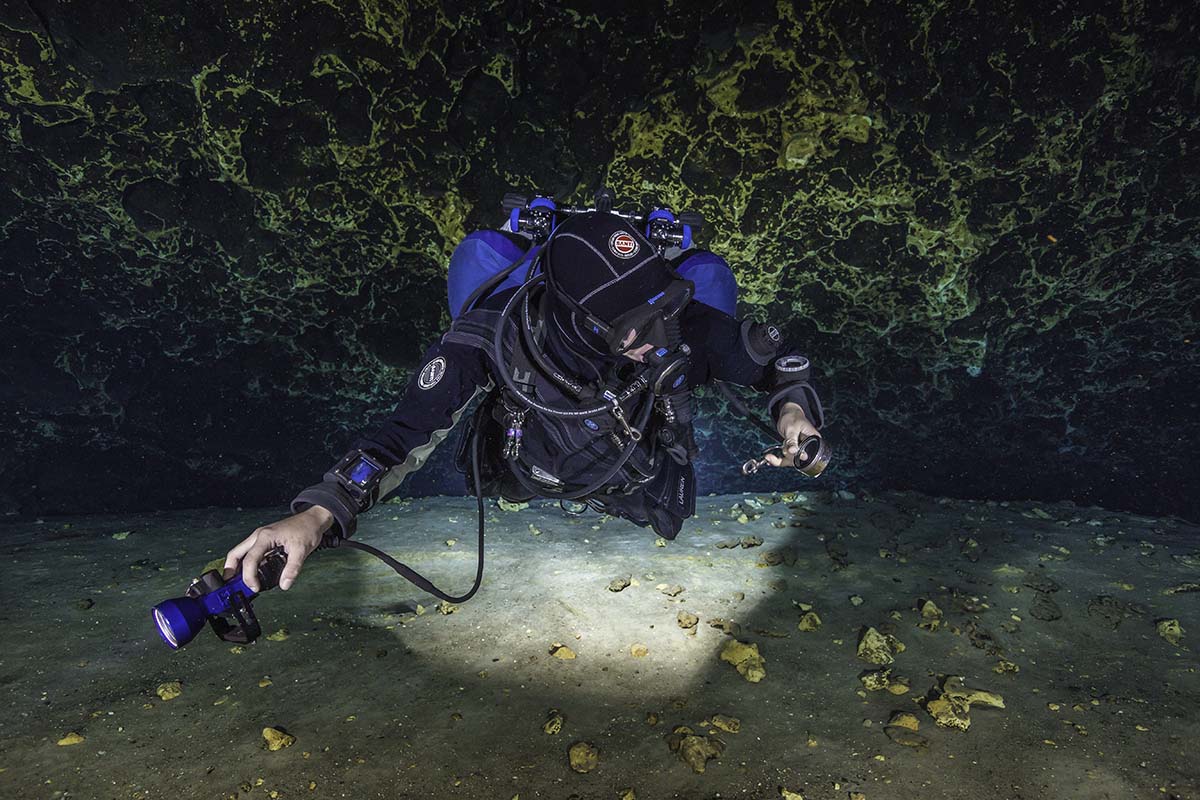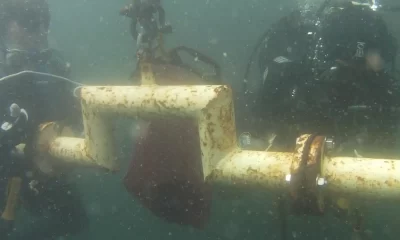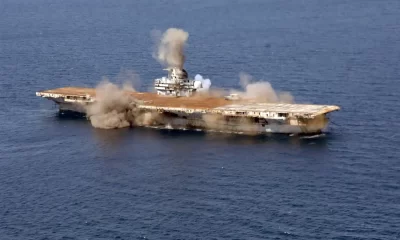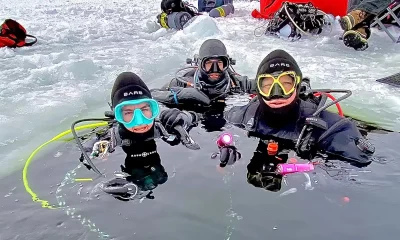Diving Safety
Why Do Divers Run Out Of Gas?
Not surprising, the answer is more complicated than simply, they neglected to look at their gauges. Here Aussie diving medical researcher and former editor of DAN’s Annual Diving Report, Peter Buzzacott dives into several deep datasets including DAN’s Incident Reporting System (DIRS) and nearly four decades of cave diving incident data, to tease out some insights on gas emergencies and get a handle on the risks. Don’t stop those S-drills!

by Peter Buzzacott
See companion story for a guestimate of the risk: What is the Risk of Running Out of Gas?
Next year it will be 30 years since I first learned to dive. At the time, I had no idea that diving would occupy such a large part of my life. I distinctly remember kneeling on the sandy bottom end of the Great Barrier Reef, sharing a regulator with my buddy, and seeing sunlight rippling down through crystal clear water. On one of these “confined water” dives we had to swim horizontally for 10 m/30 ft holding our regulators out of our mouths and blowing a steady stream of bubbles. This wasn’t as easy as it sounds and we had to ration our bubbles to make it the whole way. Then, on an open water dive, the instructor took turns holding us with one hand and gripping a rope with the other while we took a breath, took the second stage out of our mouths, and then went for the surface, breathing out all the way. Up, down, up, down, the instructor went, with each student—one at a time.

Most of today’s recreational dive courses do not include buddy breathing, they teach gas sharing with an alternate air source (AAS). Even before COVID-19, the buddy breathing skill had disappeared from most recreational training programs. The controlled emergency swimming ascent (CESA) has also disappeared from some programs.
When I became an instructor, I made many hundreds of these but, now that I think about it, I don’t recall ever seeing anyone actually make one for real after running out of gas. These days everyone dives with two second stage regulators. In technical diving, we even dive with at least two cylinders; so, I wonder, do technical divers run out of gas and, if they do, then why?
What Do The Experts Say?
Some years ago, I asked a panel of 27 diving experts a similar question regarding recreational divers in general.1 The panel consisted of nine diving/hyperbaric doctors who had treated hundreds of injured divers; nine expert dive guides, most of whom were instructors; and nine expert recreational divers who had dived all over the world and written hundreds of feature articles for dive magazines.
At the time, I suspected divers mostly ran out of gas because they didn’t pay attention to their gauge. But, to my surprise, the experts suggested about 20 reasons, such as diving deeper than usual, diving in a current, not wanting to end the dive for their buddy, using a smaller tank than their buddy, being underweighted, and many others, all of which sounded plausible.
I sent the whole list of potential causes back to the group and asked them to rank, in their opinion, the five most likely causes. Then I gave five points to everyone’s most likely potential cause, four points to the second most likely, and so on. I added up all of the points and then ranked all the causes according to the total score. Then I sent this ranked list back to the group for one last review and asked them to consider the “weight of opinion” from the group as a whole, and to reconsider their top five reasons.
As an expert panel, the group moved toward consensus. Just as I’d suspected, failing to monitor the gauge was the number one proposed potential cause of running out of gas, followed by inexperience, overexertion, inadequate training, and poor dive planning. Other than perhaps an unexpected current or underweighting leading to overexertion, the proposed reasons leaned toward human factors rather than the other two types of factors in the classic diving injury causal triad—those being environmental factors and equipment factors (Figure 1).2,3,4

The process I’d followed to gather expert consensus of opinion is called a “Delphi” process, which was originally developed by International Business Machines Corporation (IBM) to make forecasts on matters about which there was considerable uncertainty i.e. where there is little data. Opinions aren’t solid evidence; however, they can point towards a direction worth investigating.
Next, I visited Divers Alert Network(DAN) as an intern and worked on an analysis of diving fatalities within a subset of technical divers—cave divers. More on that later, but while there, I had the opportunity to examine a large dataset of recorded dives from Project Dive Exploration, headed by Drs. Richard Vann and Petar Denoble.
The dataset we had at that time revealed over 50,000 dives recorded by more than 5,000 recreational divers, (including an unknown number of technical divers). We examined these data in two ways. First, to control for environmental and equipment factors, and to focus on demographic (or human) factors, we counted each diver just once and compared those divers who had reported running out of gas, (during any recorded dive in that dataset), with divers who had not run out of gas. Surprisingly (to me), having run out of gas was more common than expected among older females (males were more likely to report other problems, like rapid ascent).
Next, to control for the human factors, we looked at just the dives made by divers who had made both at least one dive where they ran out of gas, and at least one dive where they did not run out of gas. I wanted to know what it was about those dives that might have caused the divers to run out of gas. Well, it turned out the out-of-gas dives were deeper, shorter (probably because they were deeper), often made from a live-aboard or charter boat, and involved a higher perceived workload.5 Hmmm… Perhaps overexertion was a factor after all.
After returning to Western Australia to undertake a PhD researching this, I spent the next few years recording 1,000 recreational dive profiles made by 500 divers. I recorded their start and end pressures, tank size, and noted factors such as current, how they felt their workload was (resting/light, moderate, or severe/exhausting), how many dive experiences they had, and what previous dive training they had completed. For the analysis, dives made by divers who exited with <50 bar/725 psi of pressure (needle in the red zone, n=183) were compared with other dives recorded at the same time at the same dive site (n=510) by divers who exited with >50 bar/725 psi pressure remaining (needle not in the red zone).
Ending a dive low on gas was correlated with younger males with a longer break since their last dive, fewer lifetime dives, at deeper depth, and a higher rate of gas consumption (adjusted to an equivalent surface air consumption (SAC) rate, for comparison between dives made at different depths). Perhaps more tellingly, compared with 1% of the dives with >50 bar/725 psi at the exit, 11% of the low-on-gas divers reported being surprised at the end of the dive by how low their remaining gas pressure was.6 A more detailed analysis of the average workload associated with recreational diving, using this same dataset, identified that higher perceived SAC rate was not associated with sex but was associated with older age, lower dive certification, fewer years of diving, higher perceived workload, and other factors.7
Technically Out of Gas
Returning to the topic of technical diving, a colleague and I re-examined the DAN cave diving fatality reports collection that I had worked with as an intern, and this time we concentrated on the previous 30 years of data: 1985-2015. Dividing it into two equal halves which we referred to as the “early” and “late” groups, reading each report carefully, and using a reliable cave diving fatality factors flow-chart previously developed,5 we classified factors associated with each cave diving fatality and then compared the two groups.

In the late (more recent) group, the proportion of cave divers who were trained in cave diving had significantly improved, perhaps due to increased awareness of the need for proper cave diver training before entering a flooded cave. The majority of the 67 trained cave divers in our dataset were diving with two cylinders on their back (doubles), and the late group was diving further into the cave than the early group. Of the 67 trained cave divers, 41 (62%) had run out of gas. Looking at the five “golden rules” of cave diving, the “rule of thirds” was the most common (n=20) rule that was suspected to have been broken by the trained cave divers: the most lethal.9
So, it would seem that some technical divers do run out of gas, though thankfully that appears rare. We should bear in mind that cave divers may differ from other types of technical divers in their procedures, demography, and equipment; their environment (by definition) certainly differs from that of wreck divers.
Currently, I know of no ongoing research into out-of-gas incidents among technical divers, other than the current Diving Incident Reporting System, hosted by DAN. An analysis of the first 500 reported incidents recently examined every incident—recreational and/or technical—during which the diver ran out of gas.10 The sample (n=38) was divided into two groups: those who made a controlled ascent (e.g. on a buddy’s donated regulator) and those who made rapid ascent (e.g. a bolt to the surface).
Among divers who reported having run out of gas, but survived to report the incident, 57% of the rapid ascents resulted in a reported injury. Among the 24 controlled ascents, just 29% reported an injury.10
Among divers who reported having run out of gas, but survived to report the incident, 57% of the rapid ascents resulted in a reported injury. Among the 24 controlled ascents, just 29% reported an injury.10 This modern finding is in line with the statistics reported 27 years ago by Dr. Chris Acott when he analyzed more than 1,000 diving incident reports. Examining 189 out-of-gas incident reports, Dr. Acott found 89 made a rapid ascent, and 58% of those reported an injury. Among the 79 controlled ascents, only 6% reported an injury.11
Table 1 shows the total number of dive incidents in each category, after adding both studies together. It seems to me that, while we have moved on from buddy-breathing and the controlled emergency swimming ascent, in the last 30 years the problem of running out of gas has not gone away.
| No Injury (row %) | Injury (row %) | Total (col %) | |
| Non-rapid ascent | 91 (88) | 12 (12) | 103 (50) |
| Rapid ascent | 43 (42) | 60 (58) | 103 (50) |
| Total | 134 (65) | 72 (35) | 206 (100) |
In conclusion, the evidence confirms what we all know: running out of gas is associated with diving injuries and fatalities. It appears that the level of correlation of demography information (like age and sex) with out-of-gas incidents may depend upon the study design, the pool of divers studied, and/or the specific potential causes of running out of gas being investigated. For example, in one study, older females were more likely to self-report out of gas problems; in another study, young males’ remaining gas was measured and observed to be low. In yet another study, SAC rate increased when perceived workload increased, regardless of sex.
Therefore, I’d suggest it is prudent to consider everyone potentially at risk of running out of gas and, in order to mitigate this risk, both recreational and technical divers should be proficient in gas planning and monitoring their remaining gas, regardless of age and/or sex.
[Ed.note—Most agencies today require some level of proficiency in managing emergency out of gas scenarios. For example, GUE requires divers at all levels to train regularly for this eventuality. This training also emphasizes gas management strategies like “minimum gas reserves” and the related “one third” rule to ensure divers always have enough supply to share gas aka buddy breathe from any point in the dive, and all the way to the surface. Violation of these strategies risks insufficient gas in all environments.]

Influencers
The influence of workload is interesting, and technical divers who perceive an elevated workload may well remember that this has been associated with both higher rates of gas consumption and unexpectedly running low on gas. So, when detecting a current or perceiving an elevated workload, I recommend keeping a closer-than-usual eye on the remaining gas and, if a current is suspected before the dive, then plan for an elevated SAC rate.
The influence of training/certification consistently appears to be associated with the risk of running out of gas, as does having made fewer lifetime dives. Highly trained and experienced divers might bear this in mind when diving with buddies who are newer to our sport. Offer them opportunities to gain experience and recommend additional training when they are ready. We were all inexperienced once.
Technology has improved in recent years; for example, tank pressure transponders are more reliable today than ever before. It is possible that in the future these resources, coupled with audible alarms, may prove to be highly effective at preventing technical divers from running out of gas. Until we know how effective such alarms are at preventing out-of-gas dives, our best course of action is to dive within the limits of our training and experience, and to keep an eye on our remaining gas.
See companion story for an estimate of the risk: What is the Risk of Running Out of Gas?
Do you think that it could it happen to you?
References
1. Buzzacott P, Rosenberg M, Pikora T. Using a Delphi technique to rank potential causes of scuba diving incidents. Diving and Hyperbaric Medicine. 2009;39(1):29-32.
2. Edmonds, C. and Walker, D. Scuba diving fatalities in Australia and New Zealand: The human factor. SPUMS J. 1989;19(3): 94-104.
3. Edmonds, C. and Walker, D. Scuba diving fatalities in Australia and New Zealand: The environmental factor. SPUMS J. 1990;20(1): 2-4.
4. Edmonds, C. and Walker, D. Scuba diving fatalities in Australia and New Zealand: The equipment factor. SPUMS J. 1991;21(1): 2-5.
5. Buzzacott P, Denoble P, Dunford R, Vann R. Dive problems and risk factors for diving morbidity. Diving and Hyperbaric Medicine. 2009;39(4):205-9.
6. Buzzacott P, Rosenberg M, Heyworth J, Pikora T. Risk factors for running low on gas in recreational divers in Western Australia. Diving and Hyperbaric Medicine. 2011;41(2):85-9.
7. Buzzacott P, Pollock NW, Rosenberg M. Exercise intensity inferred from air consumption during recreational scuba diving. Diving and Hyperbaric Medicine. 2014;44(2):74-8.
8. Buzzacott P, Zeigler E, Denoble P, Vann R. American cave diving fatalities 1969-2007. International Journal of Aquatic Research and Education. 2009;3:162-77.
9. Potts L, Buzzacott P, Denoble P. Thirty years of American cave diving fatalities. Diving and Hyperbaric Medicine. 2016;46(3):150-4.
10. Buzzacott P, Bennett C, Denoble P, Gunderson J. The Diving Incident Reporting System. In: Denoble P, editor. DAN Annual Diving Report 2019 Edition: A Report on 2017 Diving Fatalities, Injuries, and Incidents. Durham (NC): Divers Alert Network; 2020. p. 49-67.
11. Acott C. Diving incidents – Errors divers make. Safe Limits: An international dive symposium; 1994; Cairns: Division of Workplace Health and Safety.
12. Buzzacott P, Schiller D, Crain J, Denoble PJ. (2018). Epidemiology of morbidity and mortality in US and Canadian recreational scuba diving. Public Health 155: 62-68.
13. Buzzacott P. (editor) (2016). DAN Annual Diving Report 2016 Edition: A report on 2014 data on diving fatalities, injuries, and incidents. Durham, NC, Divers Alert Network
14. Buzzacott P (editor) (2017). DAN Annual Diving Report 2017 Edition: A Report on 2015 Diving Fatalities, Injuries, and Incidents. Durham (NC), Divers Alert Network.
15. Buzzacott P and Denoble PJ. (editors) (2018). DAN Annual Diving Report 2018 Edition: A report on 2016 data on diving fatalities, injuries, and incidents. Durham, NC, Divers Alert Network
16. Denoble PJ. (editor) (2019). DAN Annual Diving Report 2019 Edition: A Report on 2017 Diving Fatalities, Injuries, and Incidents. Durham (NC), Divers Alert Network.
You can add a diving incident to the DAN database by name or anonymously here: Diving Incident Reporting System (DIRS).

Dr. Peter Buzzacott MPH, PhD, FUHM, is a former PADI Master Instructor and TDI Advanced Nitrox/Decompression Procedures instructor, having issued >500 diver certifications. Today he is an active cave diver, holding various advanced cave diver certifications including advanced (hypoxic) trimix diver, and he is gradually gaining experience with CCR diving. To finance this, he conducts research into diving injuries and decompression/bubble modeling at Curtin University in Perth, Western Australia.





















































